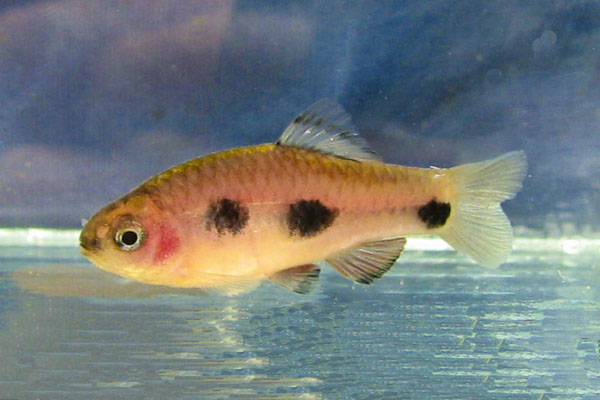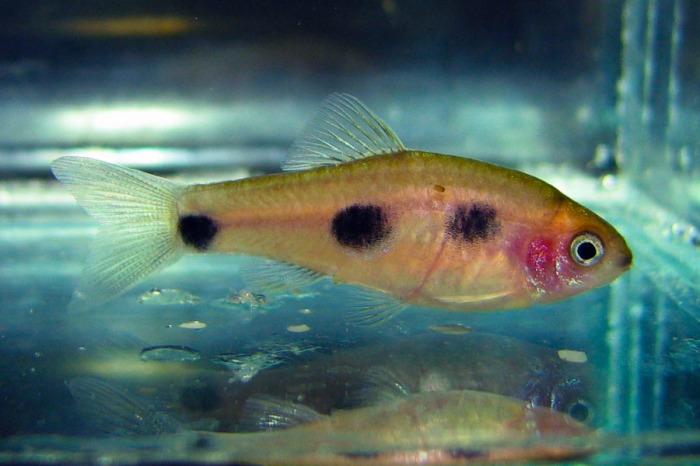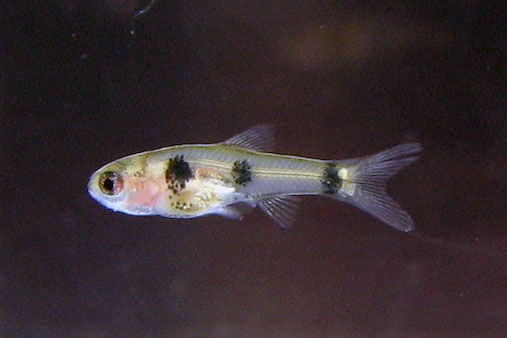Introduction

Barbus candens is a small African barb described by John Treadwell Nichols and Ludlow Griscom in 1917. It was collected by Herbert Lang and James P. Chapin near Stanleyville (now known as Kisangani) during a six-year expedition to The Belgian Congo (now called The Democratic Republic of the Congo).
B. candens is one of three similar species – the others being B. hulstaerti and B. papillo. B. candens and B. hulstaerti are rarely found in the hobby whilst B. papillo has yet to be seen.
The specific name “candens” means shining, glittering or bright.
Distribution & Availability
B. candens is found in the Congo river system and the type specimen was caught in an affluent of The Tshopo river. It is only occasionally available and commands a high price when it is seen for sale. The continuing unrest in the area means this situation is unlikely to change any time soon sadly.
Description
Males – a small barb (2.5cm) with a rather chunky profile. Pinky-beige body with three large similarly sized spots. The caudal spot is lower than the other two. Anal and ventral fins are yellowish edged in black. The dorsal fin is sky blue with a dark base and edge.
Females – similar to male but with clear fins.

Requirements
Straightforward to keep but requires soft and slightly acidic water. A very shy fish that should be kept in a species only tank as a group.
- Tank size: 30cm minimum
- Decoration: shaded areas with dense vegetation made up of fallen leaves twigs & branches.
- Temperature: 17 – 24oC
- pH: 5 – 7
- Hardness: soft, 1 – 5odH
Feeding
Will accept crushed dried foods but prefers live food such as daphnia, brine shrimp and microworm. Will also take small frozen foods.
Breeding (from John Reid)
Three male 3 female
I first received these small barbs from Alan Vaissiere and found them very easy to keep. I left them to settle for a couple of weeks in a 10” x 8” x 8” tank with a small sponge filter as the males coloured up I added black water extract and a load of java moss. You should hardly see the barbs because of the black water extract.
As barbs are egg scatterers with zero parental care you have to supply adequate places for the eggs and fry to hide. B. candens only lay small numbers of eggs every day and so it’s better if you leave the parents in for a couple of weeks or until you can see at least three or four fry. At this stage I removed the parents and started doing a 10% water change every day.
By the time you first see the fry they will be large enough to accept micromorm, walterworm & vinegar eels they will also accept very fine fry food (ZM 00 grade is a good starter).


Video of young
Summary
B. candens is a beautiful little barb that is a pleasure to keep. It’s fairly easy to breed and those fortunate to obtain some should do all they can to reproduce them and make them available to more hobbyists.
References
- Fishbase species summary
- Nichols J. T. & Griscom L. 1917. Fresh-water fishes of the Congo basin obtained by the American Museum Congo expedition, 1909 -1915. Bull. Am. Mus. Nat. Hist. v. 37 (art. 25). 653-756. (Original paper – 11.5mb in pdf format)
Hi Graham thanks for puting this in can you send me a copy of just the breeding & a little bit about the fish as livingstone club are wondering if they can but it on there web site also i could give a copy to KAS as we have just changed editor & Rab Clark is looking for new info
Thanks John can you also send a sist of the fish you would like me to lok out fot Sunday John
LikeLike